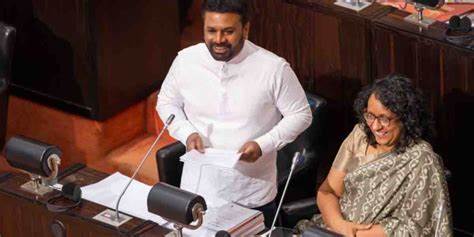
Sri Lanka’s 2025 Budget: Balancing Fiscal Discipline and Economic Growth
- CNL Reporter
- February 24, 2025
- Weekly Economic Review
- Weekly Economic Review
- 0 Comments
Weekly Economic Review
Sri Lanka’s 2025 budget, presented by President Anura Kumara Dissanayake, lays out an ambitious roadmap for economic recovery following the financial crisis of 2022. The budget prioritizes revenue generation, infrastructure investment, and adherence to International Monetary Fund (IMF) guidelines while tackling key challenges in fiscal management and economic stability.
Revenue and Expenditure Goals
The 2025 budget projects total government spending at 21.8% of the Gross Domestic Product (GDP), with a focus on social welfare programs and infrastructure development. Revenue is expected to reach 15.1% of GDP, resulting in a fiscal deficit of 6.7%—exceeding the IMF’s target of 5.2%. Additionally, the government aims to maintain a primary surplus of 2.3% of GDP, which aligns with IMF requirements.
However, concerns persist regarding the feasibility of these targets. Credit rating agencies like Moody’s have warned that weak debt affordability, a narrow revenue base, and social constraints could hamper the government’s ability to achieve fiscal consolidation. Historically, Sri Lanka has struggled to increase revenue collection, which remains a crucial factor in meeting IMF conditions and securing financial stability.
Compliance with IMF Conditions
Adhering to the IMF program is essential for Sri Lanka’s efforts to rebuild its credit rating and regain access to international financial markets by 2028. The IMF has mandated a primary surplus of 2.3% of GDP and a fiscal deficit cap of 5.2% by 2025. However, Sri Lanka’s budget deficit projection of 6.7% raises concerns about whether the country can meet these conditions. Failure to do so could delay the disbursement of critical IMF funding, including a scheduled $333 million tranche.
Budget Allocation and Investment Plans
A notable aspect of the budget is the allocation of 4% of GDP toward capital investments aimed at infrastructure and industrial development. This includes projects such as the expansion of Colombo Port and the establishment of a development bank to promote entrepreneurship. The effectiveness of these projects will depend on proper resource allocation and governance.
Assuming a GDP of LKR 20 trillion, the estimated budget figures translate to:
Total Expenditure: LKR 4.36 trillion (21.8% of GDP)
Revenue: LKR 3.02 trillion (15.1% of GDP)
Fiscal Deficit: LKR 1.34 trillion (6.7% of GDP)
Capital Investment: LKR 800 billion (4% of GDP)
While these figures reflect a commitment to growth, their success hinges on fiscal discipline and efficient execution of government policies.
Budgetary Targets and Sectorial Allocations which are different from above provisional estimates.
The government aims to increase tax revenue to LKR 4,590 billion (13.9% of GDP) in 2025, up from LKR 3,705 billion (12.3%) in 2024. Total revenue is expected to rise to LKR 4,960 billion, reflecting a stronger fiscal base. Meanwhile, recurrent expenditure will reach LKR 5,886 billion, an increase from LKR 5,340 billion in 2024.
Key budgetary components include:
Revenue Deficit: Projected to fall to LKR 906 billion from LKR 1,309 billion.
Capital Expenditure: Increased to LKR 1,315 billion from LKR 817 billion.
Interest Payments: Rising to LKR 2,950 billion from LKR 2,690 billion.
Primary Surplus: Targeted at LKR 750 billion (2.3% of GDP), up from LKR 650 billion in 2024.
Overall Budget Deficit: Expected to increase to LKR 2,200 billion, compared to LKR 2,040 billion in 2024.Domestic Borrowing: LKR 2,125 billion, while foreign borrowing is projected at LKR 375 billion.
Role of Vehicle Imports in Economic Revival
A significant component of the budget is the reintroduction of vehicle imports, which is expected to generate 1.2% of GDP in tax revenue—approximately LKR 396 billion. Beyond taxation, vehicle imports are anticipated to stimulate economic activity across multiple industries, supporting trade and commerce.
Sri Lanka had previously imposed strict import bans on over 3,000 items in 2020 to curb foreign exchange outflows. These restrictions, combined with excessive money printing, led to high inflation and a severe balance of payments crisis. The 2025 budget represents a strategic shift away from these policies, aiming for greater fiscal responsibility and economic stability.
Strengths of the 2025 Budget
The 2025 budget introduces key policy measures designed to drive long-term economic growth: Fiscal Stability and Policy Continuity – Adherence to the Public Financial Management Act ensures macroeconomic discipline and builds investor confidence.
Reform Initiatives – Plans for revising the Customs Act, launching a Digital ID system, and restructuring state-owned enterprises (SOEs) are aimed at improving business efficiency.
Digital Transformation – The introduction of the Sri Lanka Unique Digital ID (SL-UDI) and the Apex Digital Economy Authority will modernize governance and reduce bureaucracy.
Infrastructure and Energy Development – Investments in logistics, renewable energy, and port expansion signal a commitment to long-term economic sustainability.
Key Considerations and Areas of Concern
Despite these positives, the budget faces several challenges:
Support for MSMEs – While large-scale investments are prioritized, clearer policies are needed to strengthen micro, small, and medium enterprises (MSMEs).
Agriculture Sector Strategy – The allocation of LKR 254 billion to agriculture should focus on modernization and climate resilience rather than broad subsidies.
Timely Execution of Reforms – Key legislative proposals, including the National Single Window (NSW) and the Investment Protection Bill, require defined implementation timelines.
Stakeholder Consultation on New Laws – The introduction of 11 new laws demands input from industry experts to ensure effective execution.
Other concerns include:
State-Owned Enterprise (SOE) Reform – The creation of a holding company for SOEs aligns with global best practices, but independent governance and transparency will be crucial.
Labour Market Inclusivity – The budget lacks targeted initiatives to improve women’s economic participation. Flexible work policies and financial inclusion measures are necessary.
Taxation and Refund System – The shift from the Simplified Value Added Tax (SVAT) to a risk-based refund system may create short-term business disruptions.
Conclusion
Sri Lanka’s 2025 budget represents a strategic effort to stabilize the economy while fostering investment-led growth. The proposed fiscal policies align with global economic recovery trends, but effective execution remains the key to success. By maintaining fiscal discipline, ensuring stakeholder engagement, and focusing on sustainable reforms, Sri Lanka can build a resilient economy poised for long-term prosperity.

